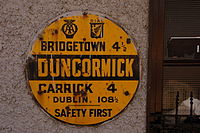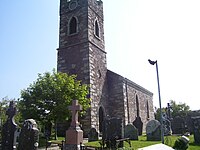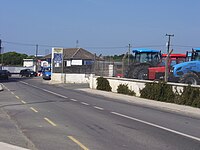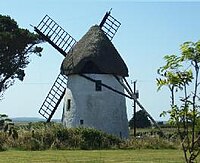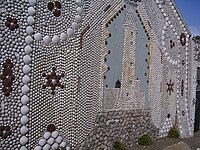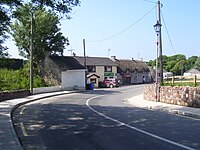Duncormick
| Duncormick Irish: Dún Cormaic | |
| County Wexford | |
|---|---|
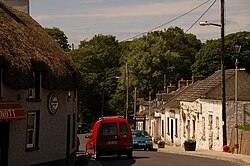 Duncormick village centre | |
| Location | |
| Grid reference: | S920089 |
| Location: | 52°13’29"N, 6°39’16"W |
| Data | |
| Population: | 116 (2016) |
| Dialling code: | 051 |
| Local Government | |
Duncormick or Duncormac is a rural village and its surrounding community in County Wexford. At the time of the 2016 census, the village of Duncormick had a population of 116 people. The village is eleven miles south-west of Wexford town, close to the fishing village of Kilmore Quay which is one of the largest fishing harbours in Ireland.
The village is beside the River Muck and on the Bannow Drive, a tourist trail and signposted route through four Wexford villages including Cullenstown, Bannow and Wellingtonbridge. It is close to a number of beaches, and a forty-minute drive from Rosslare Europort, to the east, which serves Britain and France. Waterford Airport lies to the west.
History
The name Duncormick derives from the Irish Dún Cormaic, meaning "Cormac's fortress". For many centuries before the arrival of the Normans in 1169, this part of the country was inhabited by the Tuatha Ui Bairche, whose name and territory is the basis for the modern Barony of Bargy). In the sixth century, the Ui Bairche had a powerful chief named Cormac Mac Diarmata who was for a time hailed as King of Leinster. It is possible that Cormac had a base in Duncormick.
In that early Christian, pre-Viking period, Duncormick was a prominent coastal settlement. There is a clay mound that rises behind the site of the old water mill and the modern Peace Garden, which may have been part of structures associated with this period.
In the 12th century, the first Norman forces arrived at Bannow Bay, County Wexford, commanded by Robert FitzStephen, and they made camp on Bannow Island, separated from the mainland by a narrow channel which has since silted up. A day later, two further ships arrived under the command of Maurice de Prendergast, bringing their numbers to around 600. They were joined by 500 Irish warriors led by Dermot MacMurrough, King of Leinster. From Bannow the combined armies headed towards Wexford, then a Norse seaport. There was a brief skirmish at Duncormick,[1] before they continued on to assault Wexford's walls during the Siege of Wexford (1169).
By the mid-19th century, the 1850s, the village of Duncormick had a population of about 250. The nearby Bridgetown Canal was constructed between 1850 and 1853.[2] It is 8 km in length and less than 5 minutes walk from the village centre. The canal served the communities of Bridgetown and Duncormick. While initially part of an extensive drainage and reclamation scheme, it was subsequently used as a transport system. Traffic was still common on the canal in the early 20th century, and the canal remained in use up to the 1940s.
Into the 20th century, and on a sunny day in August 1940, a German bomber aeroplane attacked the communities of Duncormick and Campile. It released four bombs over Duncormick railway station. However, the bombs missed the station, making four huge craters in a nearby turnip field. The nearby community of Campile was not so lucky,[3] and two people were killed. Not long afterward Duncormick railway station was one of a number of rural railway stations in Ireland to be closed.[4]
About the village
The village has a church, car dealership and health spa. Other business in the area include an agricultural machinery sales business, a ladies hairdresser, a horse riding facility and a doctor's surgery.
There is one pub in the village, 'Sinnotts', which is partially thatched.[5][6] A second pub, 'The Legend', has since closed down.
Duncormick is visited by walkers, equestrians and cyclists, and there is fishing in both the nearby river and the ocean. The beaches at Ballyteigue Bay and Cullenstown are close by and Ballyteigue Burrow is a nature reserve which is visited by birdwatchers. It is a protected sand dune system and a habitat for wild flowers and butterflies which covers a five and a half mile coastal stretch.
Nearby is a deserted Norman settlement known locally as The Seven Castles. It is visible from outside Wellingtonbridge. This historic estuary and peninsula is now home to birds including brent geese, wigeon, teal and some other wintering wildfowl. Close to Cullenstown village is a bungalow decorated with seashells.
Walking routes
A signposted coastal cross-country walk, from Duncormick to Kilmore Quay, starts at an old bridge on the Kilmore Quary road. The path trails along the river/canal for 30 minutes, before reaching a small beach and continues along the beach for a further 30 minutes to another large bridge. The trail reaches the protected sand dune system of Ballyteigue Burrow. Walking along the beach for a further 2 hrs leads towards Kilmore Quay and the Saltee Islands. The route ends at Kilmore Quay fishing village.
A shorter road, from Duncormick to Cullenstown, starts along rural roads, passing along the Irish Sea coast.
Events
The Killag Show (also known as the Bannow and Rathangan Agricultural Show) is held close to Duncormick every July.[7] The nearby Kilmore Quay Seafood Festival is also held in the summer (usually mid July).[8]
Other nearby events include the JFK Dunbrody Festival at New Ross, Phil Murphy Weekend at Carrig on Bannow, Viking Boat Festival at the Irish National Heritage Park, and Tagoat Steam Rally.[9]
References
- ↑ "Doyle Clan History Part 1". Doyle.com.au. http://www.doyle.com.au/history_pt1.htm.
- ↑ "Bridgetown Canal History". Slaney.iwai.ie. http://slaney.iwai.ie/btown_hist.htm.
- ↑ Smith, Hugh (1940-08-27). "4 IRISH TOWNS HIT; Girls Buried in Debris as Three Nazi Planes Drop Te... - Free Preview - The New York Times". New York Times. https://select.nytimes.com/gst/abstract.html?res=FA0A10F8385A11728DDDAE0A94D0405B8088F1D3.
- ↑ "New Ross Echo: Eyewitness account of Duncormick bombings". New Ross Echo. http://www.newrossecho.ie/news/story/?trs=cwqlididey.
- ↑ Wexford Filming Locations website
- ↑ National Inventory of Architectural Heritage
- ↑ "Bannow & Rathangan Agricultural Show". Bannow & Rathangan Show. http://bannowrathanganshow.com/.
- ↑ "Home". Kilmore Quay Seafood Festival. http://kilmorequayseafoodfestival.com/.
- ↑ "Festivals Events". Wexfordtourism.com. http://www.wexfordtourism.com/festivals_events.htm.
- Dún Chormaic / Duncormick: Placenames Database of Ireland
